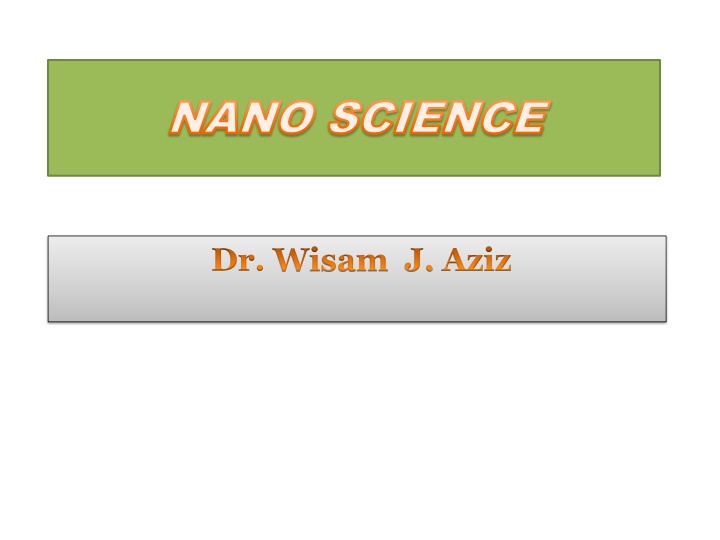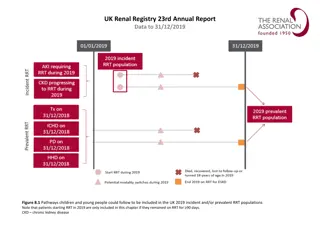
Understanding Nanoscience and Nanomaterials
Dive into the world of nanoscience and nanomaterials, exploring the nanometer scale, properties, preparation methods, production techniques, and diverse applications of this fascinating field. Discover how materials at the atomic and molecular level open up new possibilities in science and technology.
Download Presentation

Please find below an Image/Link to download the presentation.
The content on the website is provided AS IS for your information and personal use only. It may not be sold, licensed, or shared on other websites without obtaining consent from the author. If you encounter any issues during the download, it is possible that the publisher has removed the file from their server.
You are allowed to download the files provided on this website for personal or commercial use, subject to the condition that they are used lawfully. All files are the property of their respective owners.
The content on the website is provided AS IS for your information and personal use only. It may not be sold, licensed, or shared on other websites without obtaining consent from the author.
E N D
Presentation Transcript
NANO SCIENCE NANO SCIENCE Dr. Wisam J. Aziz
Contents : Introduction The nanometer scale Nano materials Properties of nanomaterials Methods of Preparation of nanomaterials Methods of Production of nanomaterials Applications of Nanoscience
Introduction : Nanoscience is a science that deals with the study and treatment of matter on the atomic and molecular scale. The origin of the word nano is derived from the Greek word (nanos) which means dwarf The nanometer is the most accurate measurement unit metric is equal to one billionth of a meter and is equal to dozens of times the hydrogen atom 1 nanometer (nm) = 10^(-9) meter
The nanometer scale Nanoscale materials are defined as a set of substances where at least one dimension is less than approximately 100 nanometers . A nanometer is one millionth of a millimeter - approximately 100,000 times smaller than the diameter of a human hair . Therefore nanoscience and nanotechnologies deal with at least clusters of atoms of 1nm size
Nano materials Nanomaterials are divided into four groups : 1- zero-dimensional materials : Materials whose dimensions are all smaller than 100 nm. Examples of these materials (quantum dots) 2- One-dimensional materials: materials that have a one-dimensional more than one hundred nanometersonly, and in the form of chips thickness of more than a hundred nanometers, and used to paint old materials to improve its electrical and mechanical properties
3 - two - dimensional materials that have a length and width of more than one hundred nanometers, such as wires and pipes and most important carbon tubesas in the figure below
4 -dimensional materials Are the materials that have a length and width and height of more than one hundred nanometers of examples of gold granules used in the treatment of cancer tumors
Properties of nanomaterials: 1- ratio of surface area of volume : Nanomaterials have a very large surface area due to volume 2- Melting point : The melting point of the material decreases when the particle size decreases because of the increase in the surface area due to volume For example, the melting point of gold is 1064 C , decreasing to about 200 C when granule size is 5 nm .
3. Magnetic and Electrical Properties : Small sizes of nanomaterials mean increased electrical conductivity and increased magnet strength and intensity
Methods of Production of nanomaterials There are two ways to Productionnanomaterials : 1. TO DOWN : From top to bottom where the original material is broken down to reach the nanoscale size and several methods are used, such as cutting, milling and grinding 2. BOTTOM UP : From bottom to top Reversing the first method, where nanoparticles are built from atoms and molecules arranged until we reach the desired shape and size. This method is often a chemical method
Methods of preparation of nanomaterials 1- Mechanical method : Crushing material, whether solid or powder, until reaching nanoparticles This method is cheap and does not require complicated device 2- Physical method It is prepared from the steam of the material by heating the material . The steam is then cooled by a neutral gas shock to become more satisfying. It is then placed on a cold surface . The nano materials are then prepared using a laser
shape of nanomaterials 1- Quantum dots 2- Nano balls 3- Nano particles 4- Nano tubes 5- Nano fibres 6- Nano wires 7- Nano composites
Applications of Nanoscience 1- In the field of medicine: Detection of diseases In the field of medicines In the field of surgery To detect and control disease . Imaging of body cells In surgries .
2- In the field of industry Glass industry Manufacture of paints and dyes Screen Industry 3. In the field of agriculture : Increase soil fertility increased agricultural production
4- In the field of energy Reduce power consumption Increase the efficiency of solar energy production Use more environmentally friendly energy systems Creating devices smaller than 100 nm ,gives us anew ways to capture , store up and transfer energy.
The risks of nano 1 - Risks to the human: A 300 nm particle has the ability to enter the human body easily and without any resistance. It can also spread and cause damage to the body, and a particle of 70 nanometers can enter the nucleus of the cell. 2 - Risks to the environment : The most important risks of nanotechnology on the environment in two forms, one of bioaccumulation and the other in small size, where it is difficult to detect and remove from the environment.






















